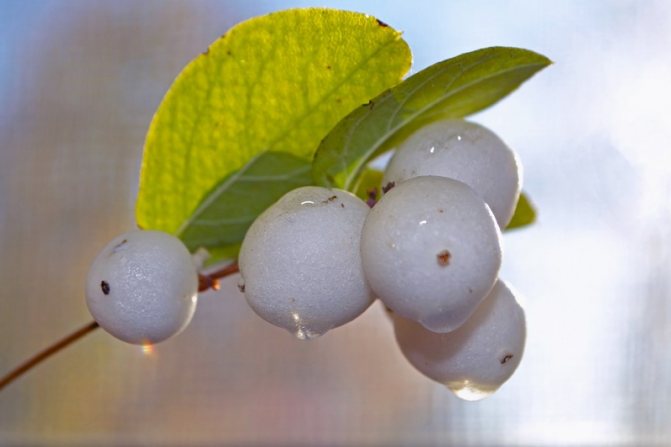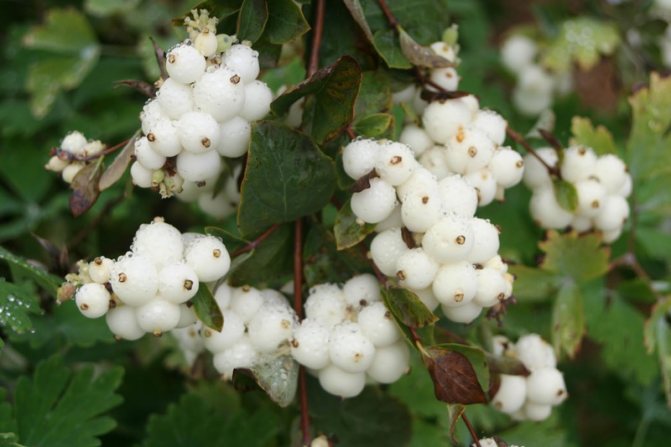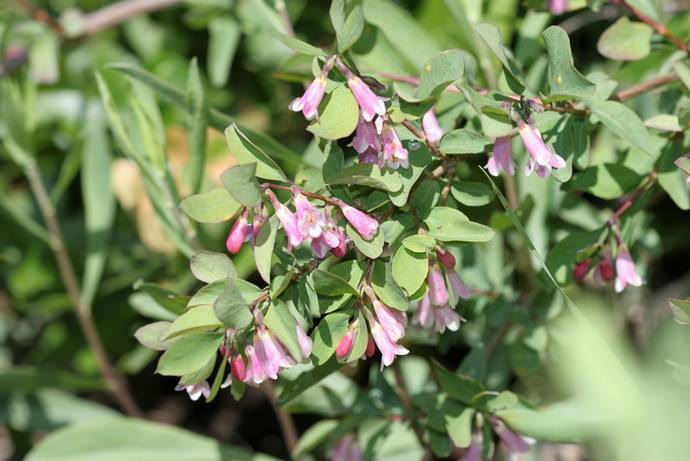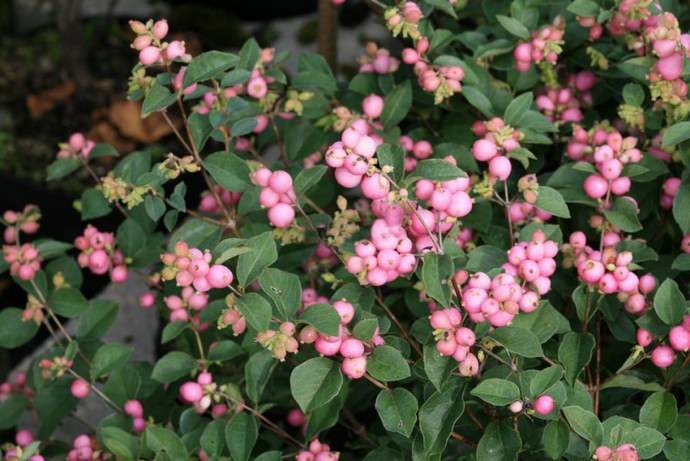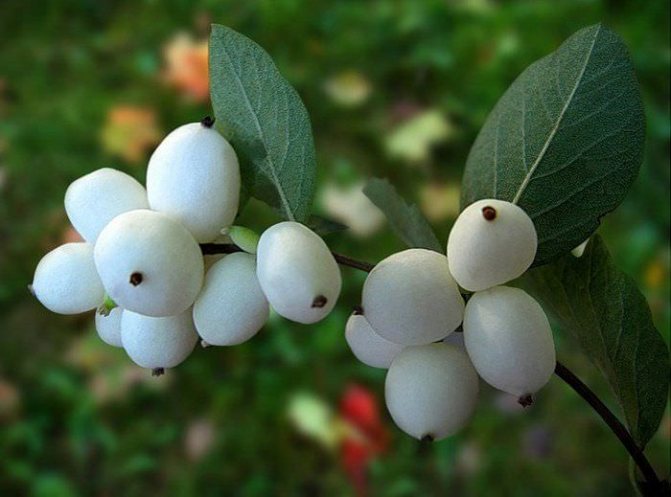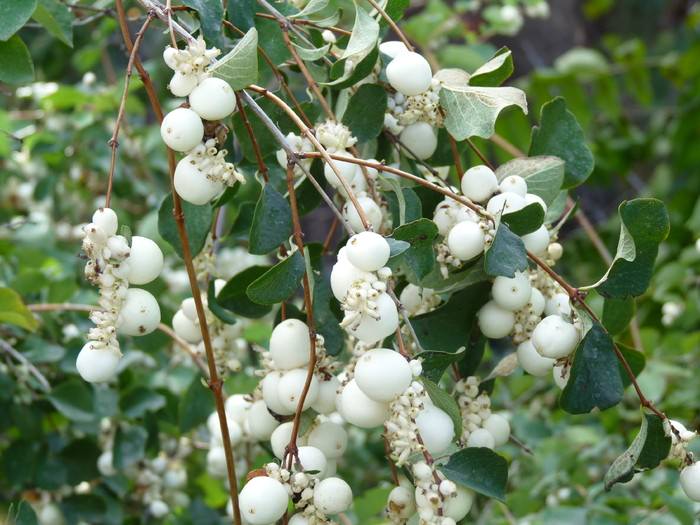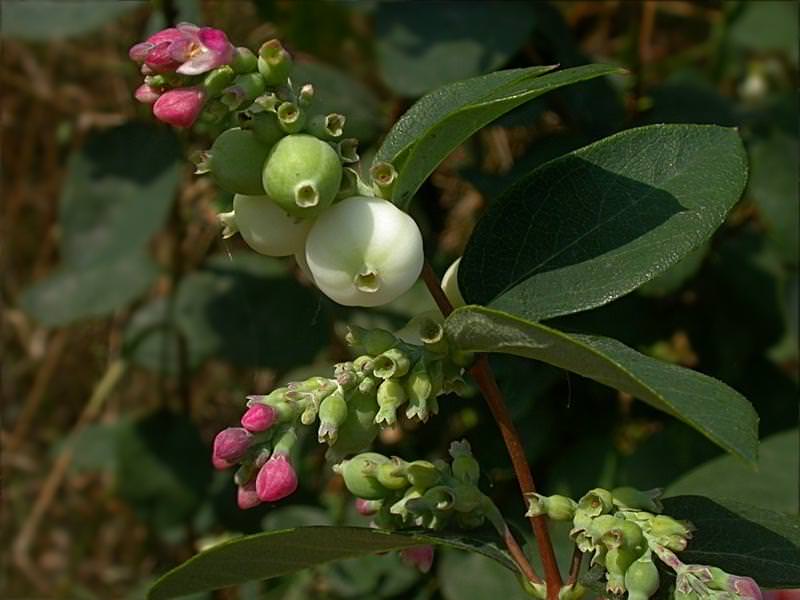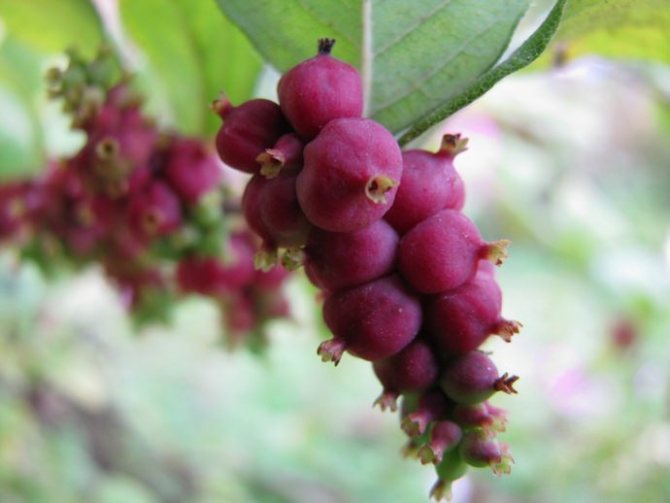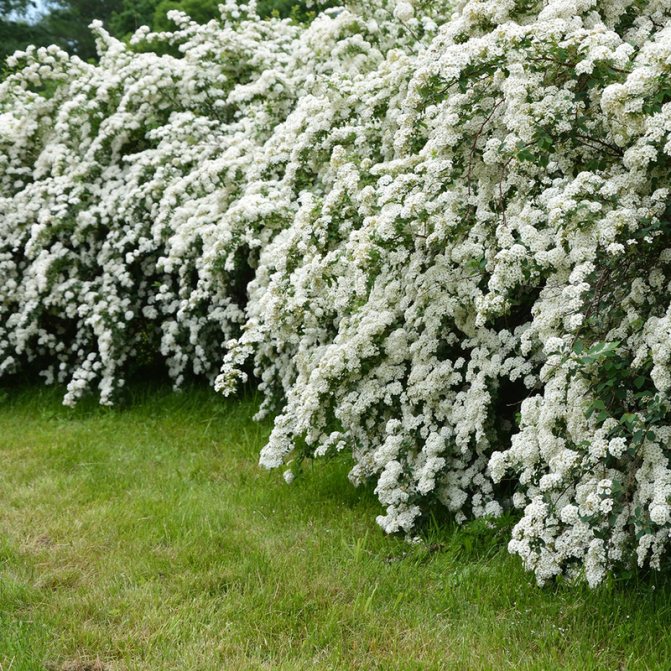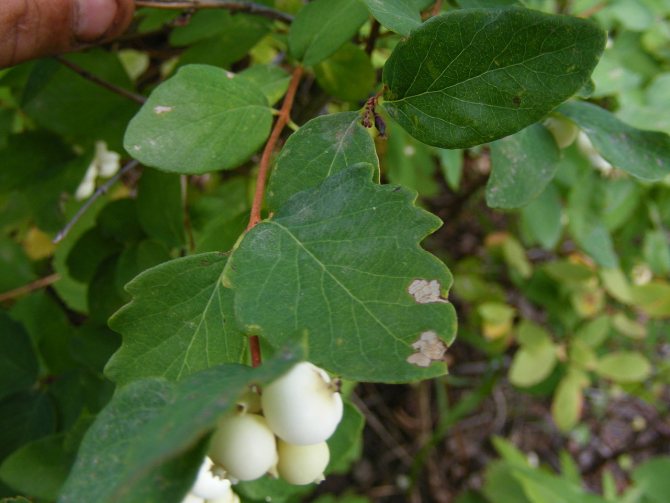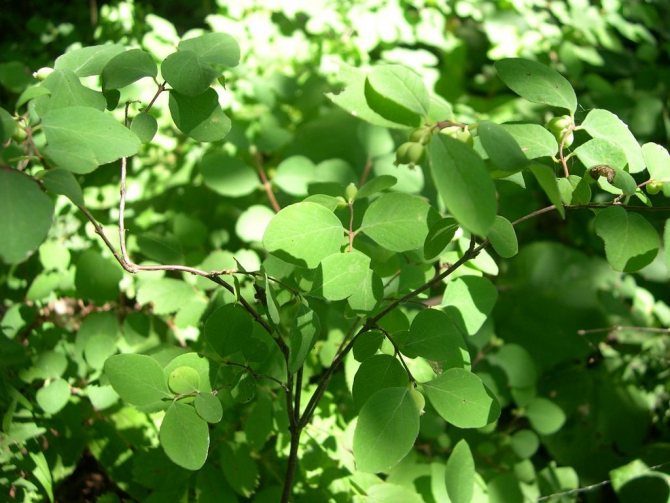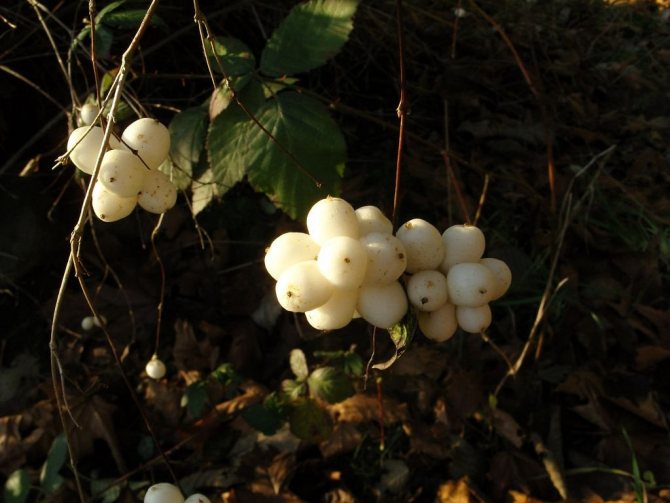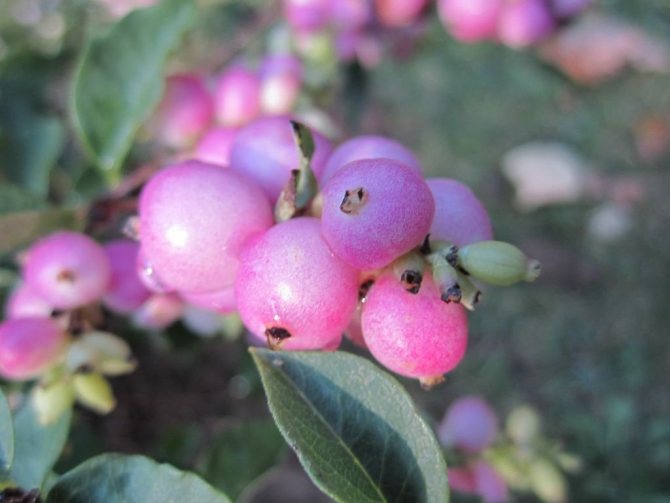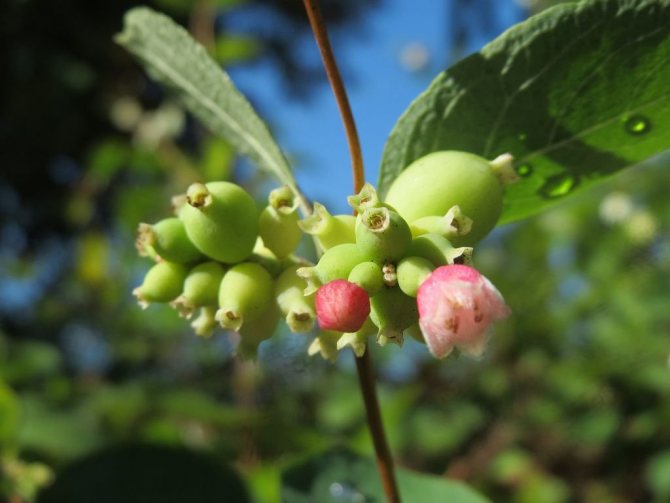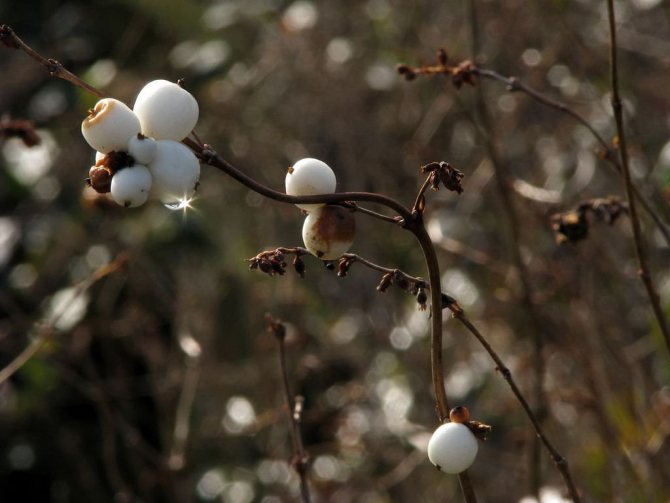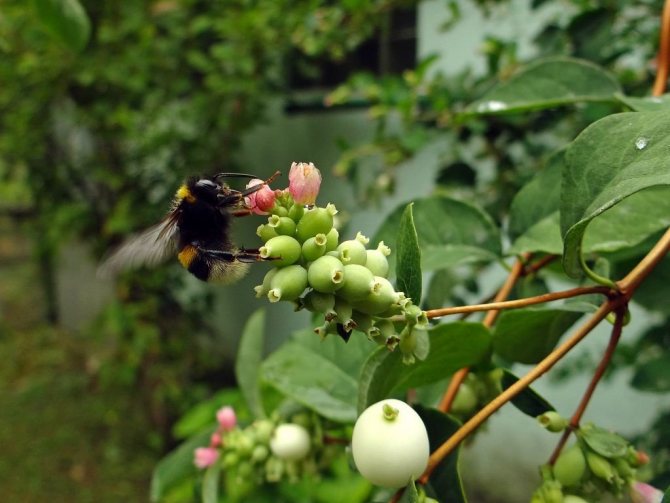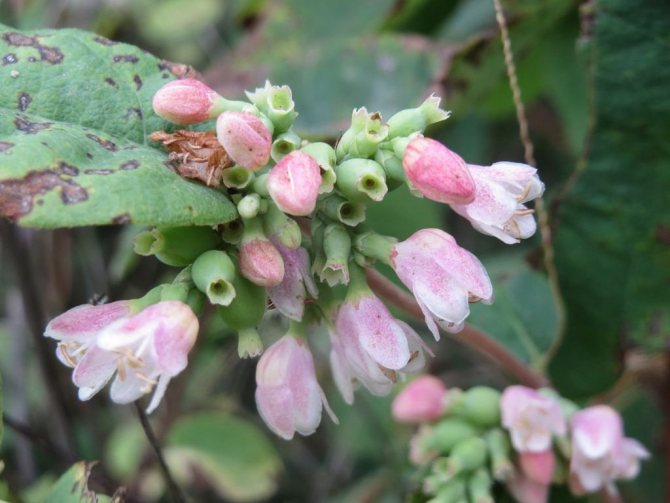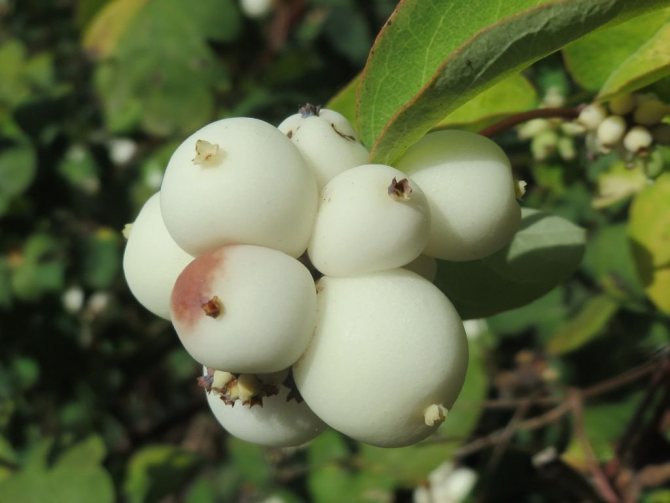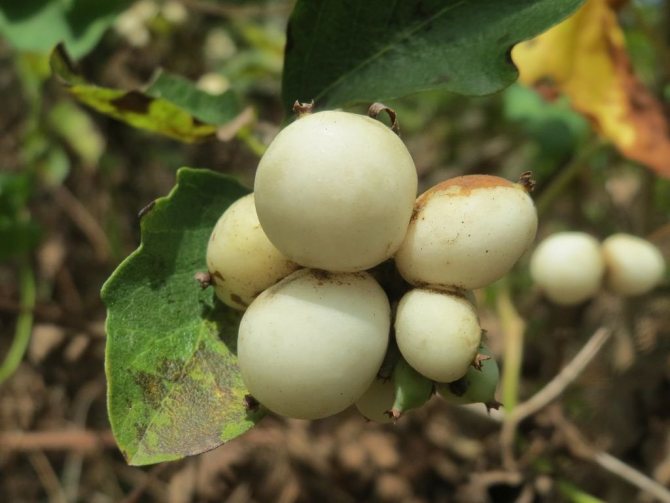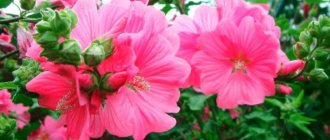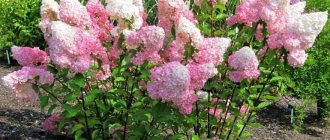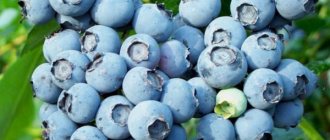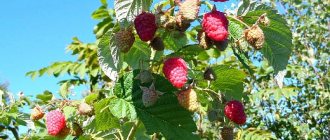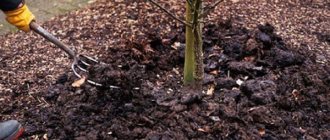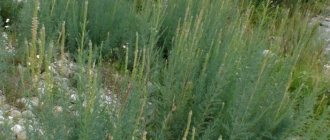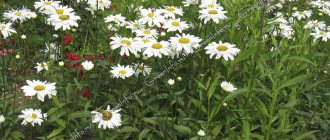The deciduous shrub snowberry (Symphoricarpos), either wolfberry or snowberry, is a member of the honeysuckle family. This plant has been cultivated for at least 200 years, while it is used to decorate squares and parks. This genus unites about 15 species in the wild, native to North and Central America. However, 1 species occurs naturally in China - this is Symphoricarpos sinensis. The name Snowberry is made up of 2 Greek words meaning "to gather together" and "fruit". So this shrub was named because its fruits are very tightly pressed against each other. The snowberry has one distinctive feature - its fruits, they do not fall off throughout almost the entire winter period, and the seeds of these berries are eaten with pleasure by quails, hazel grouses, waxwings and pheasants.
Features of the snowberry
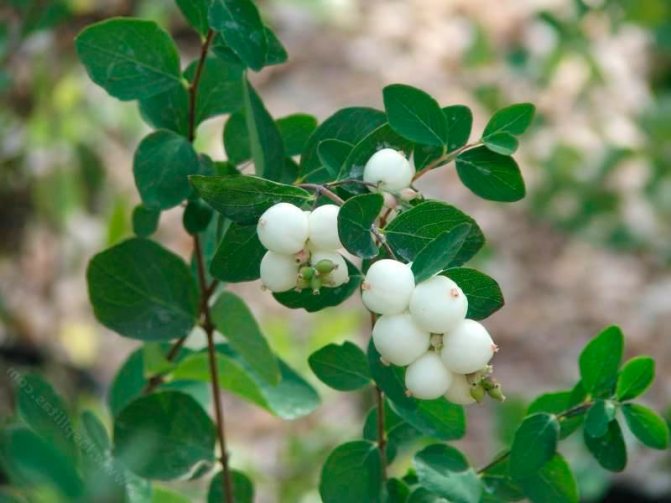
The height of the snowberry can vary from 0.2 to 3 meters. Its entire, oppositely located leaf plates have a rounded shape and a short petiole, they reach 10–15 mm in length, and there are 1 or 2 lobes at the base. In winter, the branches do not break under the weight of the snow, as they are very flexible. Terminal or axillary racemose inflorescences consist of 5-15 pieces of regular flowers of red, white-green or pink color. This shrub blooms in July or August. The fruit is a juicy drupe of spherical or ellipsoidal shape, which reaches 10–20 mm in diameter. The fruit can be colored violet-black, red, but often white, the inside of the stone is oval, compressed from the sides. The pulp of these berries looks like shiny grainy snow. These berries should not be eaten. This shrub is a good honey plant.
White (brush) snowberry is very popular among gardeners, as it is highly resistant to gas and smoke. A hedge from such a shrub looks especially impressive. This plant with pink berries prefers to grow in regions with mild winters and black soil, while it develops worse in cool climates.
Main characteristics
The snowberry or snowfield has the Latin name Symphoricarpos and belongs to the deciduous shrubs of the honeysuckle family. Native plant from North and Central America, often found in the wild. You can see it in the lower tiers of mountain forests, on the banks of rivers or rocky slopes, which indicates the plant's unpretentiousness to soils and illumination. For more than 200 years, gardeners all over the world have been cultivating the snowberry, thanks to which new varieties and hybrids have appeared.
Despite the fact that the shrub has a name associated with snow, there are varieties with pink, white-pink, reddish and exotic black fruits. All snowy berries have their own specific characteristics. These include the size and arrangement of leaves and fruits, and the height and shape of the crown.
General view of the bush
A compact bush in nature has a height of 20 centimeters to three meters, but in a summer cottage it is a great success to meet a plant of this size. As a rule, snowberries grown in the middle lane have a height of no more than two meters.Their branches are long and thin, forming a spherical or oval crown, bending under the weight of the fruit. The decorativeness of the shrub is due precisely to the type of thin flexible branches, strewn with many snow berries. The bush lends itself well to pruning, so the crown can be given any appearance.
Foliage and flowers
The leaves of the snowberry are green in color from two to five centimeters in length, oppositely located, round or oval in shape.
In the middle of summer, the shrub begins to bloom. Its flowers are regular, small, collected in 5-15 pieces in group racemose inflorescences of white, pink or red color. There are varieties with single or double flowering. As a good honey plant, the plant attracts the attention of insects. Flowering continues for a long time and alternates with the appearance of fruits.
Description of berries
Fruit ripening occurs in late autumn. With the onset of frost, when the foliage is already falling off, the fruits of the snowfield remain on the branches. Snowberry berries are juicy drupes of a round or elongated shape up to two centimeters in diameter. They fit snugly together, forming clusters. Fruits, soft to the touch, at the break have a juicy, friable pulp with two drupes. Snow berries, depending on the variety, can be not only white, but also pink, reddish, white-pink and even ink color.
The fruits do not fall off after ripening and serve as food for birds. However, eating berries can threaten a person with food poisoning, so it is necessary to explain to children that these elegant berries cannot be eaten.
Planting a snowberry in open ground
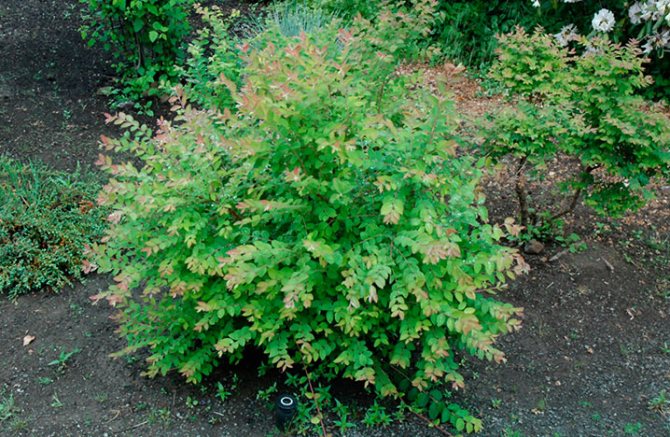

What time to plant
The snowberry is distinguished by its unpretentiousness. For its cultivation, a shaded or well-lit place, with dry or wet soil, is suitable. If this shrub is planted on a crumbling slope, then it is able to stop further destruction and erosion, thanks to its dense root system. It can be planted in open soil in autumn or spring, and at the same time it must be remembered that the soil on the site should be prepared in advance.
Landing features
In the event that you want to create a hedge, then seedlings that are 2-4 years old are suitable for you. Along the line of the designated fence, you need to pull the twine and already along it it is necessary to dig a trench 0.6 m deep and 0.4 m wide. 4 or 5 seedlings should be planted per 1 running meter of the trench. You can also plant a shrub solo or create a group planting, while a distance of 1.2 to 1.5 m should be observed between the plants.With such a planting, the size of the planting pit is 0.65x0.65 m.
A planting hole or trench should be made in advance. If planting is carried out in the fall, then you will need to prepare the landing site 4 weeks before the day of disembarkation. For planting in the spring, the place is prepared in the autumn. If the soil on the site is clay or loamy, then special attention should be paid to the preparation of the site for planting, the fact is that before the day of disembarkation, the earth in the pit should settle. A layer of rubble should be laid at the bottom of the pit, and a nutritious soil mixture consisting of peat, river coarse sand and compost (humus) should be poured onto it, while fertilizers should be added to it, for example, 0.6 kg of wood ash is taken per 1 bush, 0 , 2 kg of dolomite flour and the same amount of superphosphate. It is necessary to plant a seedling so that after compaction of the soil and its subsidence after abundant watering, the root collar of the plant is at the level of the soil surface. However, before proceeding with the direct planting, the seedling itself should be prepared; for this, its root system is immersed in a clay mash for 30 minutes. The planted plant must be provided with daily watering during the first 4 or 5 days.
Benefit and harm: medicinal properties of the bush
In medicine, the snowberry is practically not used.
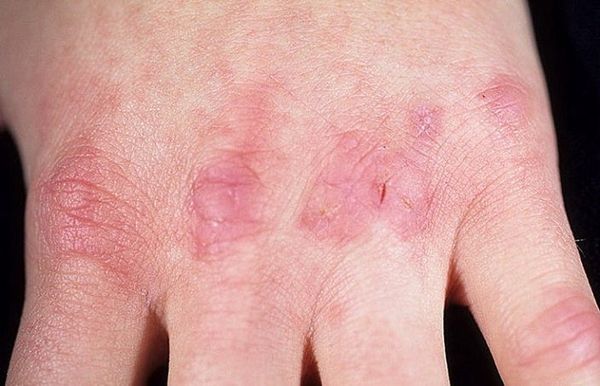

Berries help people get rid of cracked hands
There is a traditional method of treating cracked hands with fresh berries. Historical information says that the aborigines used its leaves and roots in the treatment.
Cooked based on it, medicinal drugs, powders, decoctions for the treatment of ulcers, tuberculosis and venereal diseases.
The main benefit of the snowberry is its decorative effect and the fact that it is an excellent honey plant. Its sweet flowers attract a large number of bees. It has no more healing properties.
Snowberry is poisonous
In the ornamental fruits of the snow berry contains a toxic substance... It can cause inflammation of the mucous membranes. If ingested, it causes diarrhea, vomiting and dizziness.
Due to the fact that it is poisonous, eating the berries of this shrub is contraindicated. The berries are most dangerous for curious kids. If a danger is detected, gastric lavage and medical attention are required.
There are many poisonous plants. Some of them grow in the homes of amateur gardeners. To know for sure whether your pet plant is dangerous or not, we have compiled a rating of the most dangerous poisonous indoor plants.
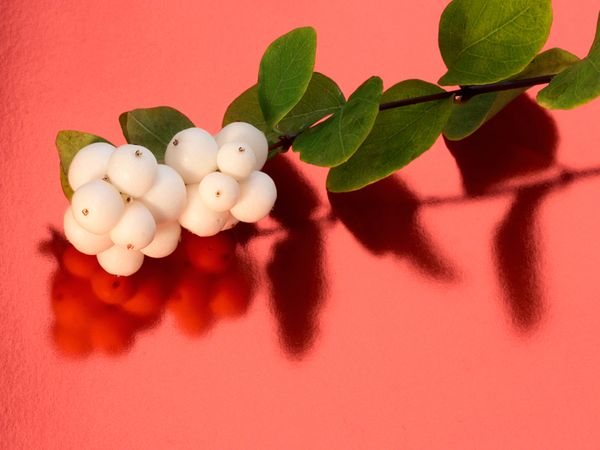

Remember that the plant is poisonous and should not be eaten!
The popular snowberry is a great garden pet. for beginner florists... It looks best in group plantings. Thinking about what to plant near the house? Feel free to make a choice in favor of a life-loving snowberry - you will not go wrong.
Caring for a snowberry in the garden
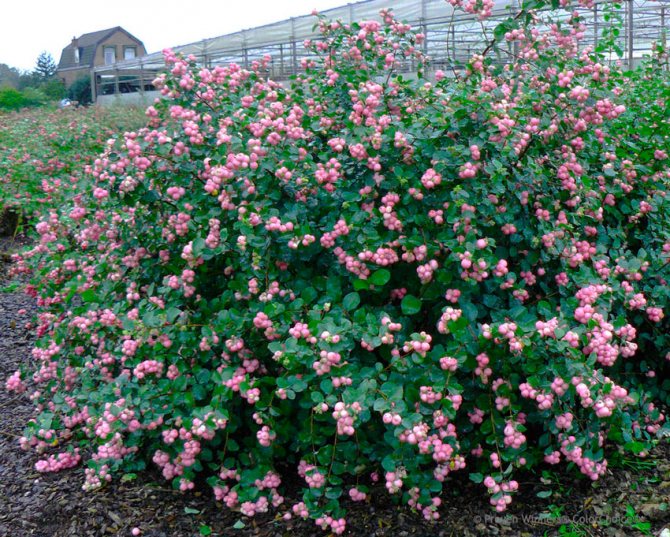

The snowberry is distinguished by its unpretentiousness and does not require special attention from the gardener. However, if you take care of him even a little, then he will have a very neat and attractive appearance. After the seedling is planted, its near-stem circle must be covered with a five-centimeter layer of mulch (peat). It is necessary to systematically loosen the soil, remove weeds in time, feed, cut, water. Also, do not forget to pay attention to protecting the snowberry from pests. The shrub should be watered only during prolonged drought. Watering is carried out in the evening, while 15–20 liters of water are poured under 1 bush. In the event that it rains regularly in summer, then this plant will not need watering. It is best to loosen the soil or weed after watering or rain. In autumn, the soil near the bush should be dug up.
In spring, the snowberry should be fed by adding 5 to 6 kilograms of humus (compost) to its trunk circle, as well as 0.1 kilograms of potassium salt and superphosphate. If this is necessary, then the second feeding is arranged in the middle of the season, for this a nutrient solution is used, consisting of 1 bucket of water and 50 grams of Agricola.
Transfer
If there is a need to transplant a snowberry, then you should hurry up. After the bush has a powerful root system, it will be very difficult to carry out this procedure. Such a shrub quickly and easily adapts to a new place. The transplant is carried out in the same way as the initial landing and at the same time. In order for this procedure to end successfully, it is necessary to dig out the bush in such a way that its roots are injured to a minimum. The radius of the root system in an adult snowberry is on average 0.7 to 1 meter. Therefore, you should dig in the bush, stepping back at least 0.7 m from it.
Pruning


Pruning does not harm the snowberry. It is best to carry out this procedure at the very beginning of the spring period, while sap flow has not yet begun. All injured, dried out, damaged by frost, disease or pest, thickening and too old branches should be removed. Those branches that remain must be cut by ½ or ¼ part. You should not be afraid to prune, since the laying of flower buds occurs on the shoots of this year.It should also be noted that after a shearing, the snowberry recovers very quickly. If the cuts on the branches exceed 0.7 cm in size, then do not forget to process them with garden pitch. A shrub that is over 8 years old needs rejuvenating pruning, as its foliage and flowers become smaller, and the stems grow short and weak. Such pruning is carried out "on a stump" at a height of 0.5 to 0.6 m. During the summer period, new powerful stems will grow from the dormant buds present on the remains of the stems.
Diseases and pests


Such a plant is highly resistant to diseases and pests. And this is most likely due to the fact that this plant is poisonous. Very rarely, powdery mildew can disturb this shrub, and rot sometimes appears on the berries. For preventive purposes, in early spring, before the buds swell, it is necessary to process the bushes with a solution of Bordeaux liquid (3%). In order to cure an infected plant, it should be treated with a fungicide, for example: Fundazol, Skor, Topsin, Titovit Jet, Topaz, Quadris, etc.
Care
Although Buldenezh is unpretentious, he still needs minimal care, like any living plant, especially if you want the flowers to bloom larger in the spring and the bush to grow well.
Plant care activities include, of course, watering, infrequent feeding until the bulldozer rises and becomes an adult, pruning dry and old branches.
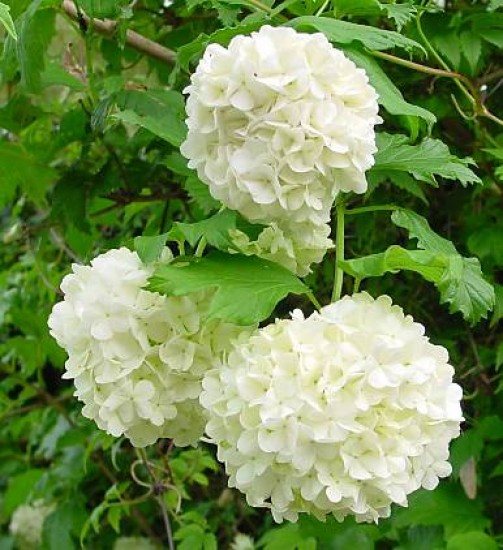

- Watering As mentioned above, Buldenezh is a very moisture-loving plant, so you need to water it as often as possible, as moisture leaves the ground, especially on dry days of summer. If watering will satisfy the need of the shrub, the flowers on the branches will be large and juicy.
- You can start feeding Buldenezh in the second or third year after planting, since you have well prepared the hole for the plant and put enough nutrients in it - they should be enough to adapt and start healthy growth for two to three years. The first feeding is done in the spring, when they start the first leaves appear, it should be using nitrogen fertilizers.
The second top dressing is done in the fall, before leaf fall, this time potash-phosphorus fertilizers are used.You can fertilize with top dressings diluted in water, or dry granules, scattering them under the bushes and loosening the ground with glanders, then spilling abundantly with water.
The proportions should be when diluted in water: 25-35 grams per bucket.
- Cleaning Buldenezh cleaning should be carried out annually, then the branches will be well renewed and bloom more violently. Pruning of Buldenezh viburnum can be carried out in early spring, before the start of sap flow, or in late autumn, after the foliage has fallen. Young plants planted a year or two ago do not need to be cleaned.
Snowberry breeding
Such a shrub can be propagated in a generative (seed) way and vegetatively: by layering, cuttings, dividing the bush and root shoots.
How to grow from seeds


Growing a snowberry from seeds is a rather laborious and time-consuming process. But if you want, you can try. First you need to separate the seeds from the pulp of the berries, then they are folded into a nylon stocking and squeezed well. After that, the seeds must be poured into a not very large container filled with water. The mixture is thoroughly mixed. Then you need to wait until the seeds settle to the bottom, while the pieces of pulp should float. Remove the seeds and wait for them to dry well.
Seeds are sown before winter. This should not be done in open soil, since small seeds in spring can come off along with the snow cover. For sowing, boxes should be used, which must be filled with a nutritious substrate consisting of peat, river sand and humus, which must be taken in a 1: 1: 1 ratio.Seeds must be spread over the surface of the substrate, and then sprinkled with a thin layer of sand. The container must be covered with glass. In order not to wash the seeds, watering should be done through a sump or using a fine spray gun. Seedlings can be seen in the spring. It will be possible to pick seedlings directly into open soil at the end of the season.
How to propagate by root shoots


A lot of root suckers grow near the shrub, they create large and rather dense clumps. Therefore, this plant is able to actively grow and move from the planting site. Dig out the curtain you like and plant in a permanent place. By the way, this will help prevent thickening of the bush.
Reproduction by dividing the bush
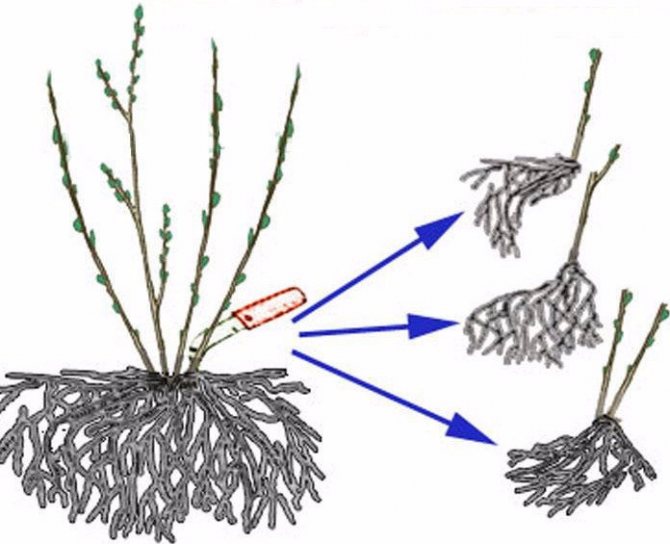

The division of the bush can be done in early spring, before sap flow begins, or in autumn, when leaf fall ends. To do this, an overgrown shrub is chosen, dug up and divided into several parts. Then the delenki are planted in new permanent places, following the same rules that are used for the initial planting. You should pay attention to the fact that each delenka should have strong developed roots and young healthy branches. At the cuttings, it is also necessary to process the cut points on the root system with chopped charcoal.
How to propagate by layering


At the very beginning of spring, you need to choose a young branch that grows near the surface of the soil. It is laid in a groove dug in the ground and fixed in this position, and then covered with a layer of earth, while the top of the layer should not be covered. During the season, the layering must be looked after, as well as the shrub itself, namely: water, feed and loosen the soil surface. By the fall, the cuttings will have to give roots, it is cut off from the parent bush with pruning shears and planted in a permanent place.
Cuttings
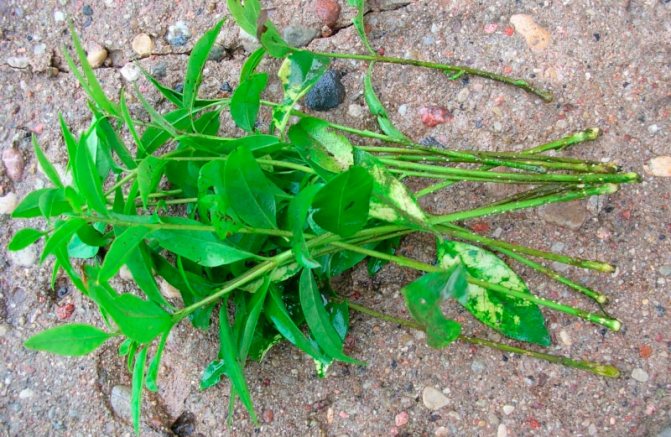

For propagation of such a plant, it is recommended to use lignified or green cuttings. The harvesting of lignified cuttings is carried out at the end of the autumn or at the beginning of the spring. Their length can vary from 10 to 20 centimeters, with 3-5 buds on each cut. They are stored in the sand in the basement until spring. The upper cut is made over the kidney, and the lower cut obliquely.
Harvesting green cuttings is carried out early in the morning at the beginning of the summer period, and this should be done almost immediately, as the shrub fades. Large, mature and well-developed shoots are suitable for cutting. To understand whether a certain shoot can be used as a cutting, a simple test is carried out; for this, it is simply bent. In the event that the shoot breaks and a crunch is heard at the same time, this indicates its maturity. Prepared cuttings should be placed in water as soon as possible.
For rooting, both lignified and green cuttings are planted in containers filled with soil mixture (the composition is the same as when sowing seeds). They can be deepened no more than 0.5 cm. Then the container is removed to a greenhouse or a greenhouse, since high humidity is required for rooting cuttings and at the same time moderate soil moisture. By the onset of autumn, the cuttings should have developed a good root system, they can be planted in a permanent place, not forgetting to cover them with spruce branches or dry foliage for the winter.
Care
A place.
It is best to grow Kalina Buldenezh in light partial shade. In a sunny place, flowering will be shorter. In the shade - very weak, with small loose inflorescences. And the pests will torture you there.
Viburnum Bulldonezh does not have berries, but it blooms amazingly. Loves slightly acidic soil and moist, but not swampy
It happens that the place seems to be suitable, and the soil meets all standards, and the shrub does not want to grow or bloom in any way. In this case, you urgently need to look for another place for Kalina.It must be remembered that the bulldoze is planted for several decades, so the choice of a place is a responsible matter.
The soil.
Kalina Buldenezh grows well on loose, nutritious, moderately moist soil. It is very important to prepare a good planting hole for it, at least 50 cm x 60 cm in size. Fill it with a soil mixture with a large supply of nutrients.
For example, mix several buckets of compost, peat and sand. Wood ash (at least 3 glasses) and nitrophoska or fertilizer granules (amount according to the instructions) are added to them. This is very important for successful bulldozing.
Heavy clay soil needs to be cultivated by adding humus, peat and sand to it.
Winter hardiness.
The snow globe is a fairly winter-hardy crop that does not need to be covered for the winter. However, in the first years of life, it is advisable to insure yourself and at the end of autumn insulate the roots with humus.
This simple work will not only protect them from freezing in severe winters with little snow, but also feed the plant. If you sow lawn grasses under a bush, or keep an existing lawn during planting, then dense turf will become reliable protection in any weather.
In winters that are too frosty and with little snow, the bulldozer can freeze a little. But it quickly overgrows with absolutely healthy shoots.
Planting viburnum Buldenezh is carried out in early spring or late autumn, just before the frosts.
- Spring, when all the plants wake up and the process of vital activity is activated, is a good time for planting by any method.
- If it is decided to plant a shrub in the fall, this will give the seedlings time to adapt, but the plant can only be planted this season by dividing the root.
Buldenezh has inflorescences consisting of sterile flowers, therefore it reproduces only vegetatively. Viburnum is propagated by cuttings, layering, root, offspring.
The breeding method of viburnum Buldenezh will depend on which method of planting you have chosen.
It is very easy to plant a shrub by dividing the root. If you already have this plant on the site, you need to find a suitable lateral process of the young growth and carefully separate it from the mother bush - that's it, the seedlings are ready.
Planting a shrub by layering will also not be difficult. To do this, you just need to bend the lower extreme branch to the ground and pin it down with a wire bracket.
From above, the layering is sprinkled with earth and kept moist until it takes root and shoot. Then it is separated from the large bush - and it can be transplanted to a separate place.
Planting a shrub with a cut is a little more difficult, since it takes more time for it to root.
If there is only one branch available for reproduction of the viburnum (the growth of the current year), then you can try to grow several plants from it at once at home.
The twig is divided into small segments, consisting of two nodes (each with a pair of leaves) and one internode.
When grafting, the lower pair of leaves is removed, and the leaf blade of the upper pair of leaves is shortened by half.
The lower part of the cuttings is immersed in a growth stimulant solution (phytohormones). The holding time of the cuttings in the solution is in accordance with the instructions; for example, cuttings are kept in a solution of heteroauxin (100 mg per liter of water) for 10-16 hours.
The pots are filled with a substrate (turf, sand, humus in a ratio of 3: 1: 1) and cuttings are planted in them, deepening them by 1.5-2 cm, squeezed with soil, watered and placed in a "greenhouse bag" for rooting.
Rooted viburnum cuttings can be grown in pots at home until late autumn, and then removed to the basement until spring. In early spring, pots with cuttings are brought from the basement to the house, and in May, young plants are planted in the garden.
Snowberry after flowering
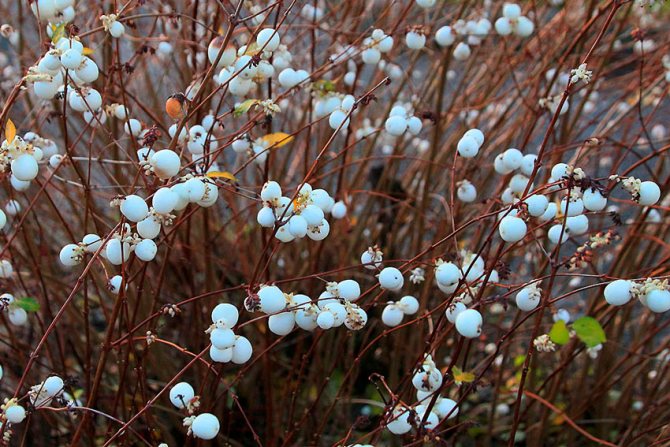

When grown in mid-latitudes, the snowberry does not need shelter.Even its hybrid varieties, which are highly decorative, can withstand frost down to minus 34 degrees. However, if the winter is very frosty, then the plant may suffer, but during the growing season it must recover. If the bush is young, then for wintering it should be highlighted with soil.
Is it a poisonous shrub with white berries?
Round berries of a snow-white color ripen at the end of summer, after which they hibernate on a shrub plant until the onset of spring heat. Despite the rather attractive and seductive appearance, such berries are absolutely inedible and can cause poisoning.
Nevertheless, the toxic effect is exclusively on humans, and many birds eat the fruits with great pleasure in the winter. Domestic flower growers use snowberries only as an ornamental plant.
Types and varieties of snowberry with photos and names
Snowberry white (Symphoricarpos albus)
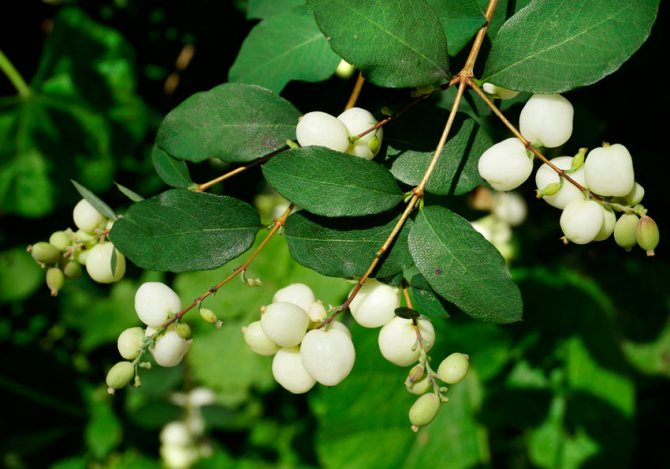

This type is considered the most popular, and it has several names, namely: the snowberry is white, either brushy, or carpal. It is found naturally in North America from Pennsylvania to the west coast, with a preference for growing on riverbanks, open slopes, and mountain forests. The bush can be about 150 centimeters high. This deciduous shrub has a rounded crown and slender stems. The leaf plate has a rounded or ovoid shape, it is simple, whole-edged or notched-lobed. The length of the leaves is about 6 centimeters, their front surface is green, and the back is gray. Lush, brush-shaped inflorescences are placed along the length of the entire stem, they consist of small light pink flowers. The shrub blooms luxuriantly and for a very long time. Therefore, at the same time, you can admire beautiful flowers and spectacular white fruits, which are a juicy ball-shaped berry with a centimeter diameter. The fruits do not fall from the bush for a very long time.
This plant is very unpretentious and has a high frost resistance. It has been cultivated since 1879. Often, hedges and borders are created from such a snowberry, and it is also used for group plantings. The berries of this plant cannot be eaten, they contain substances that, getting inside the human body, cause weakness, dizziness and vomiting. This species has a variety that is quite popular among gardeners - a white, slightly shiny snowberry (Symphoricarpos albus var.laevigatus).
Common snowberry (Symphoricarpos orbiculatus)


This species is also called pink, or round, or coral. And where this species comes from, it is called "Indian currant". In nature, this shrub grows in North America on river banks and in meadows. Such a snowberry has a large bush with thin stems and small dark green leaves, which have a bluish seamy surface. Short lush inflorescences consist of pink flowers. Quite spectacularly, such a shrub will overcame in the autumn, it is at this time that red-purple or coral berries of a hemispherical shape begin to ripen on the stems, which are covered with a bluish bloom, while the leaf plates turn purple.
The common snowberry does not have high frost resistance compared to the previous species. But at the same time, it overwinters quite normally when grown in the middle lane. This plant has gained high popularity in Western Europe, the Taffs Silver Age variety, which has a white edging on the leaf plates, is in special demand here, as well as Variegatus - an uneven pale yellow strip runs along the edge of the leaves.
Western snowberry (Symphoricarpos occidentalis)
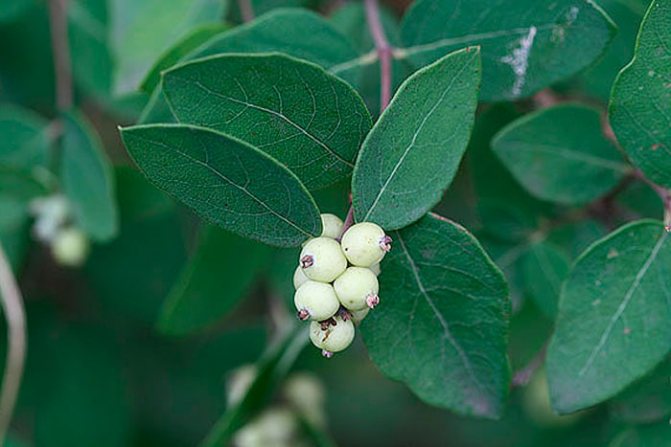

This species is from the western, eastern and central regions of North America. It creates thickets along streams, rivers and rocky slopes.The bush is about 150 centimeters high. The front surface of the leaf plates is pale green, while on the seamy there is a felt pubescence. The short and dense, brush-shaped inflorescences consist of light pink or white bell-shaped flowers. The shrub blooms from the first days of July to the last days of August. Then soft fruits of an almost spherical shape appear, which are painted in white or light pink.
Mountain-loving snowberry (Symphoricarpos oreophilus)


Originally from the western regions of North America. The bush can reach a height of 150 centimeters. The shape of the weakly pubescent leaf plates is round or oval. Single or paired bell-shaped flowers are painted white or pink. Inside the spherical white berries there are 2 seeds. Possesses average frost resistance.
Chenot's Snowberry (Symphoricarpos x chenaultii)


This hybrid was created by crossing a small-leaved snowberry and an ordinary snowberry. Not very tall bush has dense pubescence. The length of the sharp leaf plates is about 25 mm. Fruits are pink with white cheeks. Has a relatively low frost resistance.
Chenaultii Snowberry (Symphoricarpos x chenaultii)
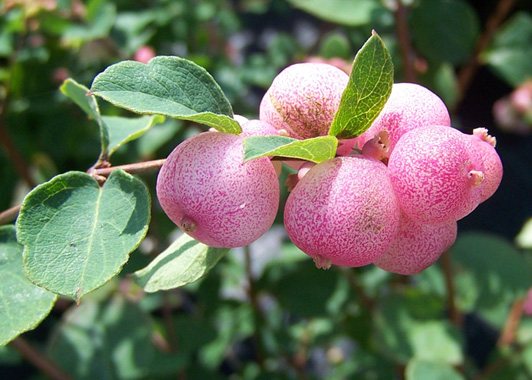

This hybrid plant has a height of one and a half meters, its crown diameter is also 1.5 m. The front surface of the leaf plates of a bright dark green color, while the wrong side is gray. The foliage grows very early, while it stays on the branches for a long time. The inflorescences consist of pink flowers. The berries are rounded, they can have a color from purple to white, stay on the bush for a relatively long time. The most successful variety is the Hancock snowberry.
Dorenboz's Snowberry (Symphoricarpos doorenbosii)
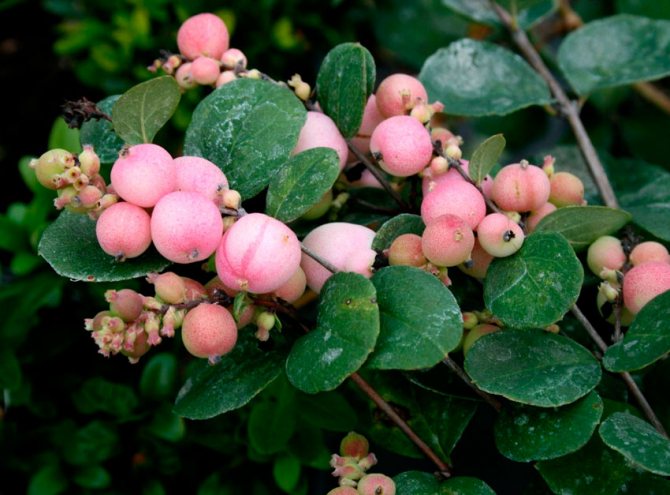

This is a group of hybrid varieties that were created by the Dutch breeder Doorenbos. He got them by crossing a rounded snowberry with a white snowberry. Varieties differ among themselves by the abundance of fruiting and compactness:
- Mather of Pearl... Elliptical leaf plates are dark green in color. The berries are white with a slight blush.
- Magic Berry... The shrub bears fruit very abundantly. Its branches are covered with deep pink berries.
- White Hage... On an upright, dense bush, there are small white fruits.
- Amethyst... It has a very high frost resistance. The height of the shrub is about 1.5 m. The color of the leaf plates is dark green, and the nondescript flowers are light pink. The pink-white berries are round in shape.
In addition to the species that are described here, the following are cultivated: round-leaved, small-leaved, Chinese, soft and Mexican.
Popular varieties
In nature, there are 15 species of snowberry shrubs. Some of them have become very popular with gardeners.
Snowberry white
Most popular view for landscaping sites and landscape design. The view is not whimsical to care for. Suitable for the main description of the culture, the fruits are white, soft. Flowering occurs in mid-summer (white, slightly pinkish, greenish) and lasts until autumn.
The variety is loyal to the soil composition. It tolerates urban living conditions well. Frost resistant. Grows up to 1 meter.
Snowberry pink
Very beautiful shrub, meter height. The branches are flexible, the leaves are small, dark green in color. Flowering occurs in August. The flowers are pink in color. By autumn, the berries ripen (coral or purple-red).
Late foliage falls in autumn and its branches, decorated with fancy berries, continue to delight the eye. The variety is not frost-resistant. Suitable for cultivation in the southern regions.
Dorenboz's Snowberry
Hybrid variety, named after a breeder from Holland. Combined several different varieties and species of plants of this group.
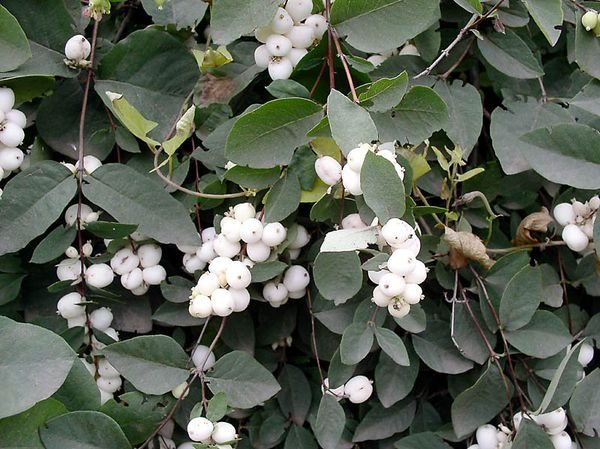

Variety White
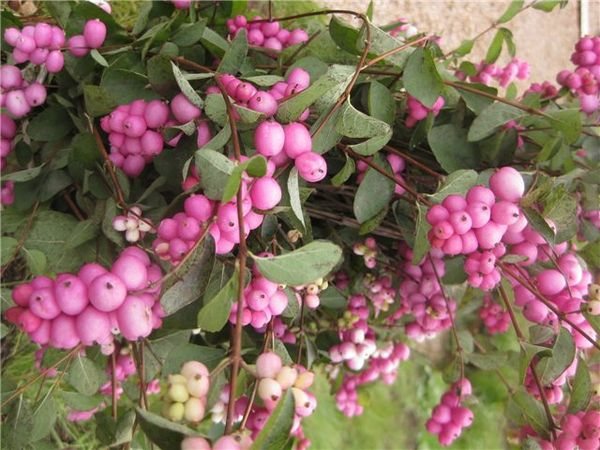

Variety Pink
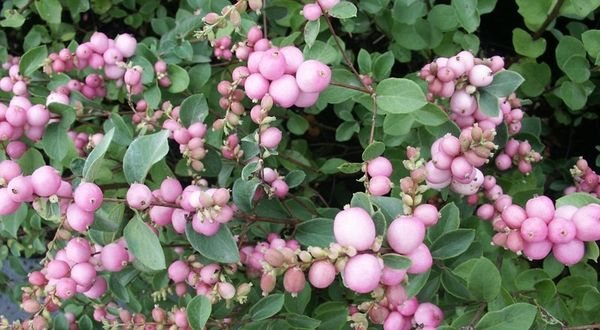

Dorenboza Mother of Pearl
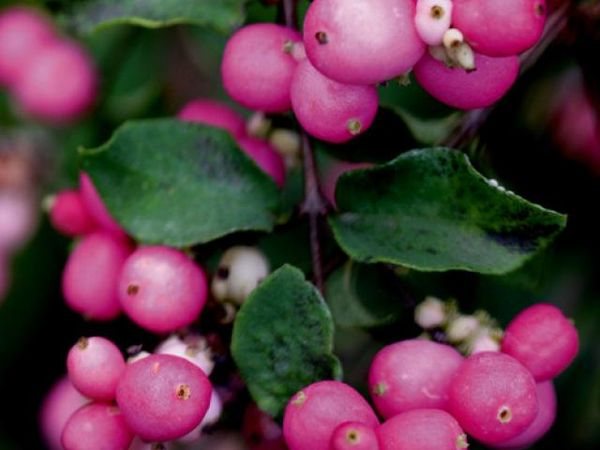

Dorenboza Magic Berry
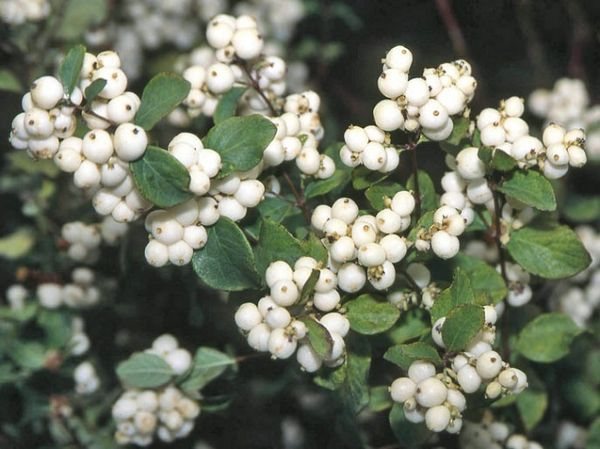

Dorenboza White Hedge
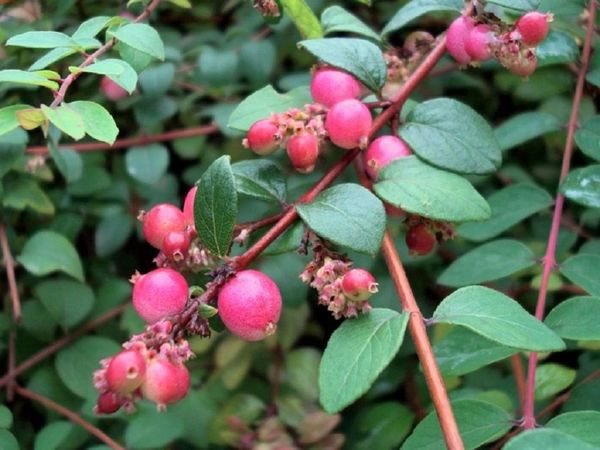

Chenot variety
Dorenbose differs in:
| Variety | Features of the |
| Magic Berry | height 0.6 -1 meter, raspberry-colored berries. The leaves are miniature bright green. Not frost resistant |
| Amethyst | height 1.5 meters, the foliage is dark green, the fruits are round, white with pink barrels. Requires winter shelter |
| Mother of pearl | height up to 1.8 meters. Leaves are dark green, oval, blooms in July with pink flowers. The fruits are large, white-pink. Unpretentious care. Suitable for hedges. Conditionally frost-resistant |
| White Hedge | height 1.5 meters. Fruits are decorative, like white balls. The bloom is pink and racemose. The fruits are collected in bunches. Tolerates pruning well. Not picky about care. Considered a popular variety |
| Chenot | hybrid variety, very popular because of its frost resistance. Grows short, less than 1 meter. The fruits are elegant, pink. Chenot is a hybrid of pink snowberry |
Content
- Listen to the article
- Description
- Planting a snowberry in open ground When to plant
- How to plant
- How to grow
- Seed reproduction
How to prune
Snowfield pruning is best done in early spring, before bud break. It should be borne in mind that flower buds are formed on the shoots of the current year. After pruning, the shrub will actively and easily recover.
When pruning to form a crown, the shoots should be shortened by about half or one quarter of their length. Sanitary pruning refers to the removal of dry and damaged branches. This should be done regularly.
Over time, the snowberry shrub loses its neat appearance: the shoots weaken and shorten, and the leaves and flowers become small. To renew the old bush, they carry out anti-aging pruning. If you completely cut the bush at a height of 40 - 60 cm, new strong shoots develop from dormant buds over the summer.
After pruning, the places where the branches are cut are processed with garden varnish.
When and where to plant a snowberry plant
The culture is also not demanding on the composition of the soil; it grows well on stony and calcareous lands. She easily adapts to the growing environment. The site for planting must be properly prepared. Without a drainage cover, the snowberry can get wet. Perhaps this is the only disadvantage of a rapidly forming shrub.
Tags: planting, secret, snowberry, care
About
«Previous post
Application in landscape design
You can combine wolfberry with many plants, which will be described below.
An example of decorative compositions: Wangutta spirea, wolfberry, veriegatny dogwood, in the background - mountain ash. Photos in the garden:
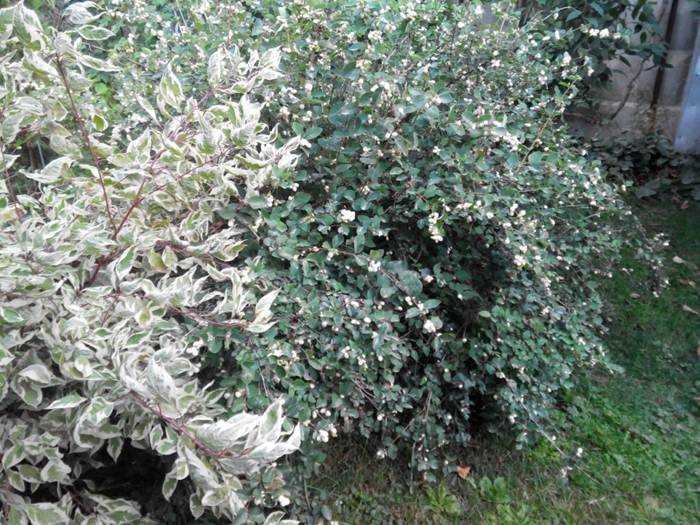

The combination with dark green conifers looks very beautiful and picturesque. Against a background of vivid contrast, white berries will create an ornate hedge. Photo:
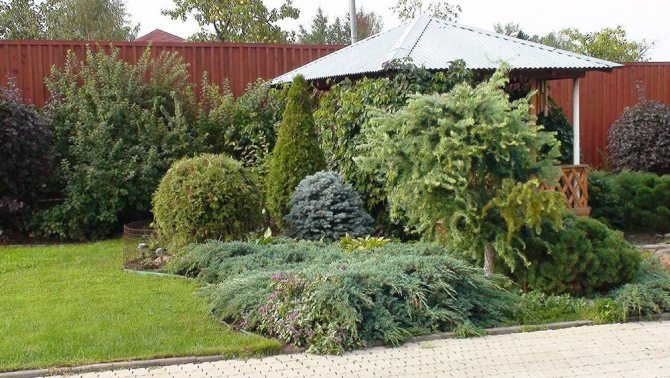

Description of the plant
Snowberry - shrubs of medium size, not exceeding 1.5 m.Its branches are long and graceful, which, when fruits appear, begin to bend, making city-loving shrub spreading and beautiful, with a spherical shape.
The leaves of the snowberry are slightly oblong, oval, green-marsh-colored. During the flowering period, the whole plant is covered with small pink flowers that grow evenly throughout the shrub, which delight with their beauty for 1.5-2 months.
Snowberry leaves photo:
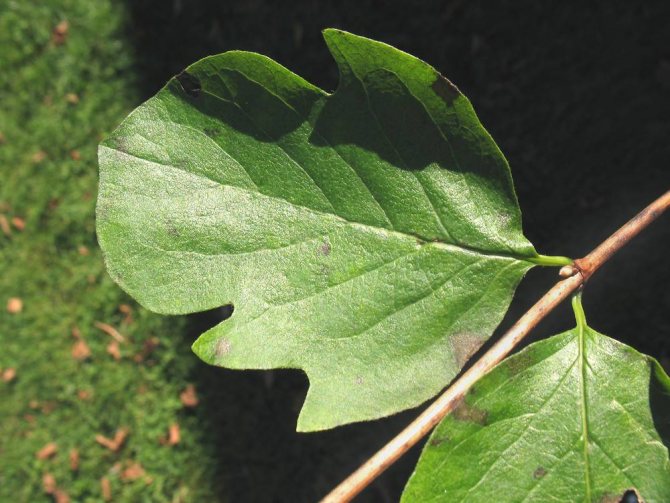

The berries are in clusters, large, spherical, the color range varies depending on the variety. They remain on the branches even after the leaves fall, and can remain until spring. These qualities make it a beautiful addition. in landscape design... More often than others, you can see the variety doribosa magic berry and dorenboza magic candy.
Diseases and pests
Since wolfberry is a poisonous plant, it is not affected by pests. It is also resistant to various infections. In rare cases, with poor care, infection with ash, gray rot can occur. To save the bush, it is necessary to use chemicals: Strobi, Falcon, Maxim, Skor, etc. Traditional methods (for example, rubbing with soap or alcohol solution) will not help.
For the prevention of diseases in early spring, the bushes need to be treated with Bordeaux liquid 3%. This will reduce the chances of developing fungus.
Medical use
The healing properties of the plant have practically not been studied. Information has reached us that the indigenous people of America used berries, pounded to a mushy state, to treat purulent wounds and ulcers, and a decoction of the bark was used for sexually transmitted diseases, tuberculosis, but no real recipe was found.
Modern medicine does not use berries. Although traditional medicine recommends them for wounds and irritations on the hands, as well as for making the skin soft and smooth. Several berries are rubbed, applied to damaged areas, and after a few hours washed off with soap and water. For cracks on the soles of the feet, rough keratinized skin on the feet, it is also possible to use a mixture of crushed berries. It is not recommended to keep the composition longer than 3-5 hours, the course is 7-10 days. The best result is given by the white snowberry.
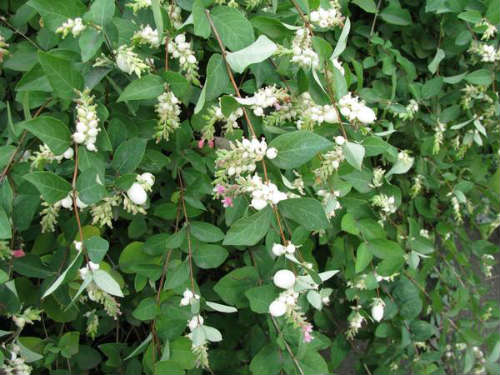

Snowball - planting an unpretentious bush
The snowberry bush is ideal for decorating a summer cottage. Any free place will fit for planting a bush: in the sun or in the shade, on a hillock or in a damp lowland - an unpretentious plant feels great in any conditions.
Watering the bushes in dry season should be at the rate of approximately 20 liters of water (2.5 buckets) per square meter of area. It is recommended to do this in the evening and not too often. If the natural soil moisture is sufficient, additional watering is not needed. After watering or rain, it is convenient to weed and loosen the soil around the bush.

